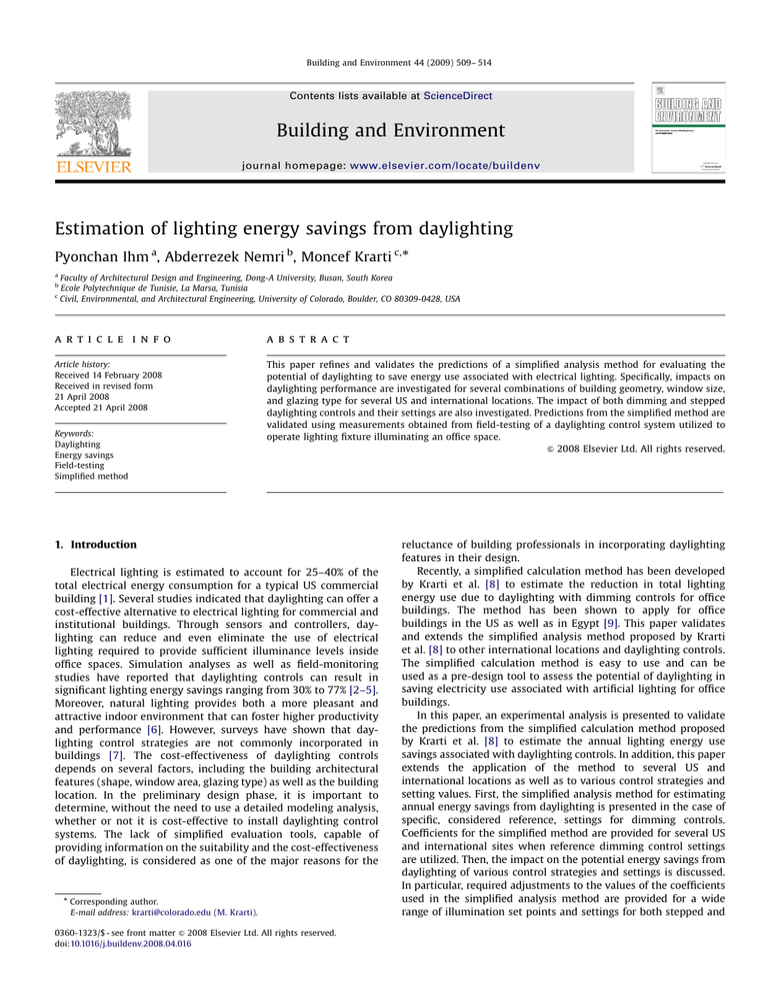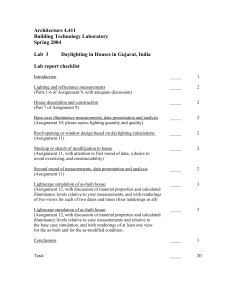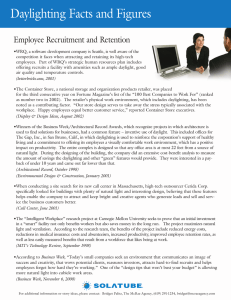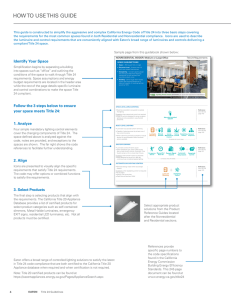
ARTICLE IN PRESS
Building and Environment 44 (2009) 509– 514
Contents lists available at ScienceDirect
Building and Environment
journal homepage: www.elsevier.com/locate/buildenv
Estimation of lighting energy savings from daylighting
Pyonchan Ihm a, Abderrezek Nemri b, Moncef Krarti c,
a
b
c
Faculty of Architectural Design and Engineering, Dong-A University, Busan, South Korea
Ecole Polytechnique de Tunisie, La Marsa, Tunisia
Civil, Environmental, and Architectural Engineering, University of Colorado, Boulder, CO 80309-0428, USA
a r t i c l e in fo
abstract
Article history:
Received 14 February 2008
Received in revised form
21 April 2008
Accepted 21 April 2008
This paper refines and validates the predictions of a simplified analysis method for evaluating the
potential of daylighting to save energy use associated with electrical lighting. Specifically, impacts on
daylighting performance are investigated for several combinations of building geometry, window size,
and glazing type for several US and international locations. The impact of both dimming and stepped
daylighting controls and their settings are also investigated. Predictions from the simplified method are
validated using measurements obtained from field-testing of a daylighting control system utilized to
operate lighting fixture illuminating an office space.
& 2008 Elsevier Ltd. All rights reserved.
Keywords:
Daylighting
Energy savings
Field-testing
Simplified method
1. Introduction
Electrical lighting is estimated to account for 25–40% of the
total electrical energy consumption for a typical US commercial
building [1]. Several studies indicated that daylighting can offer a
cost-effective alternative to electrical lighting for commercial and
institutional buildings. Through sensors and controllers, daylighting can reduce and even eliminate the use of electrical
lighting required to provide sufficient illuminance levels inside
office spaces. Simulation analyses as well as field-monitoring
studies have reported that daylighting controls can result in
significant lighting energy savings ranging from 30% to 77% [2–5].
Moreover, natural lighting provides both a more pleasant and
attractive indoor environment that can foster higher productivity
and performance [6]. However, surveys have shown that daylighting control strategies are not commonly incorporated in
buildings [7]. The cost-effectiveness of daylighting controls
depends on several factors, including the building architectural
features (shape, window area, glazing type) as well as the building
location. In the preliminary design phase, it is important to
determine, without the need to use a detailed modeling analysis,
whether or not it is cost-effective to install daylighting control
systems. The lack of simplified evaluation tools, capable of
providing information on the suitability and the cost-effectiveness
of daylighting, is considered as one of the major reasons for the
Corresponding author.
E-mail address: krarti@colorado.edu (M. Krarti).
0360-1323/$ - see front matter & 2008 Elsevier Ltd. All rights reserved.
doi:10.1016/j.buildenv.2008.04.016
reluctance of building professionals in incorporating daylighting
features in their design.
Recently, a simplified calculation method has been developed
by Krarti et al. [8] to estimate the reduction in total lighting
energy use due to daylighting with dimming controls for office
buildings. The method has been shown to apply for office
buildings in the US as well as in Egypt [9]. This paper validates
and extends the simplified analysis method proposed by Krarti
et al. [8] to other international locations and daylighting controls.
The simplified calculation method is easy to use and can be
used as a pre-design tool to assess the potential of daylighting in
saving electricity use associated with artificial lighting for office
buildings.
In this paper, an experimental analysis is presented to validate
the predictions from the simplified calculation method proposed
by Krarti et al. [8] to estimate the annual lighting energy use
savings associated with daylighting controls. In addition, this paper
extends the application of the method to several US and
international locations as well as to various control strategies and
setting values. First, the simplified analysis method for estimating
annual energy savings from daylighting is presented in the case of
specific, considered reference, settings for dimming controls.
Coefficients for the simplified method are provided for several US
and international sites when reference dimming control settings
are utilized. Then, the impact on the potential energy savings from
daylighting of various control strategies and settings is discussed.
In particular, required adjustments to the values of the coefficients
used in the simplified analysis method are provided for a wide
range of illumination set points and settings for both stepped and
ARTICLE IN PRESS
510
P. Ihm et al. / Building and Environment 44 (2009) 509–514
dimming control strategies. Finally, the simplified method predictions are validated against measured data obtained for a small
office space equipped with dimming control.
2. Simplified analysis method
To determine the percent savings, fd, in annual use of artificial
lighting due to daylighting implementation using daylighting
controls in office buildings, Krarti et al. [8] found that the
following equation can be used:
f d ¼ b½1 expðatw Aw =Ap Þ
Ap
Af
(1)
where tw is the visible transmittance of the window glazing and
Aw/Ap the window to perimeter floor area. This parameter provides
a good indicator of the window size relative to the day-lit floor area.
Ap/Af is the perimeter to total floor area. This parameter indicates
the extent of the day-lit area relative to the total building floor area.
Thus, when Ap/Af ¼ 1, the whole building can benefit from
daylighting; a and b are coefficients that depend only on building
location and control strategy. The coefficient b represents the
percent of time in a year that daylighting illuminance level can
provide the required design illuminance set point, Eset. In other
terms, the coefficient b measures the daylighting availability during
building operating hours in a given geographical location.
The product of the two coefficients a and b can be estimated
from readily available data, including the annual average outdoor
illuminance level on vertical surfaces, Ev,out, the illuminance set
point, Eset, and a daylighting control parameter, k [8]:
ab ¼ k
Ev;out
Eset
(2)
To estimate the coefficients a and b, a whole-building simulation program has been utilized [10]. The simulation tool, DOE-2.1,
considered in the analysis presented in this paper is capable of
modeling whole-building energy performance, including envelope
components as well as heating, ventilating, and air-conditioning
(HVAC) systems. In particular, the simulation tool can model the
energy performance of several daylighting control systems.
Similar to the work carried out by Krarti et al. [8], several officebuilding configurations were considered in the simulation
analysis with various shapes. Typical building construction
materials, HVAC systems, as well as densities and schedules for
occupancy, lighting, and equipment are used to model office
buildings in various climates. In particular, typical office lighting
schedule is assumed for all locations (correspondent to
8:00 am–6:00 pm during week days). Lighting density was set at
1.3 W/ft2 (14.0 W/m2) in accordance with the ASHRAE/IES standard office value [10]. In the analysis presented in this paper, only
the results associated with lighting energy use are considered
even though daylighting controls can also affect significantly the
energy required by the HVAC systems [9].
For this analysis, interior movable shades are modeled in
conjunction with a maximum glare value of 22 and a maximum
solar heat gain of 30 Btu/ft2 h (95 W/m2) [10]. If either of these
thresholds is exceeded, shading is deployed. Unlike the work
performed by Krarti et al. [8], which analyzed the effectiveness of
daylighting controls within small perimeter office rooms, the
current analysis focuses on the impact of daylighting for typical
office buildings with open perimeter areas.
Table 1 provides the coefficients a and b for several locations
throughout the world when a continuous dimming daylighting
control is utilized to maintain 50 fc (foot-candle, 500 lx) on the
working plane along the perimeter areas. For each location,
the coefficients a and b were determined based on an extensive
Table 1
Coefficients a and b of Eq. (1) for various locations throughout the world
Location
a
b
Location
A
b
Atlanta
Chicago
Denver/Boulder
Phoenix
New York city
Washington, DC
Boston
Miami
San Francisco
Seattle
Los Angels
Madison
Houston
Fort Worth
Bangor
Dodge city
Nashville
Oklahoma city
Columbus
Bismarck
Minneapolis
Omaha
19.63
18.39
19.36
22.31
18.73
18.69
18.69
25.13
20.58
16.60
21.96
18.79
21.64
19.70
17.86
18.77
20.02
20.20
18.60
17.91
18.16
18.94
74.34
71.66
72.86
74.75
66.96
70.75
67.14
74.82
73.95
69.23
74.15
70.03
74.68
72.91
70.73
72.62
70.35
74.43
72.28
71.50
71.98
72.30
Casper
Portland
Montreal
Quebec
Vancouver
Regina
Toronto
Winnipeg
Shanghai
K-Lumpur
Singapore
Cairo
Alexandria
Tunis
Sao Paulo
Mexico91
Melbourne
Roma
Frankfurt
Kuwait
Riyadh
19.24
17.79
18.79
19.07
16.93
20.00
19.30
19.56
19.40
20.15
23.27
26.98
36.88
25.17
29.36
28.62
19.96
16.03
15.22
21.98
21.17
72.66
70.93
69.83
70.61
68.69
70.54
70.48
70.85
67.29
72.37
73.68
74.23
74.74
74.08
71.19
73.63
67.72
72.44
69.69
65.31
72.69
simulation analysis using the same methodology described in
Krarti et al. [8].
3. Sensitivity analysis
As indicated earlier, the coefficients listed in Table 1 are
obtained for continuous dimming controls with a desired
illuminance level of 50 fc (500 lx) on a desk plane (with a height
of 0.762 m or 2.5 ft). For other daylighting control settings and
illuminance set points, the coefficients a and b listed in Table 1
need to be adjusted. A series of parametric analyses have been
carried out to determine the effect of various daylighting control
settings and strategies on the coefficients a and b. The results of
the parametric analyses are summarized below.
3.1. Effect of illuminance level set point
The indoor illuminance level required by building standards
and codes on the working plane vary widely among countries and
depend on the activity levels [1]. The effect of the desired
illuminance level on the performance of daylight control has been
determined for various locations. Fig. 1 illustrates the impact of
illuminance level on the annual energy use savings in electrical
lighting due to daylighting for Atlanta and Boulder/Denver area.
As expected, the higher the required illuminance level, the lower
are the potential energy savings from daylighting. However, for
large daylighting aperture, the same energy savings are achieved
regardless of the illuminance set point. That is, the coefficient b in
Eq. (1) is not affected by the illuminance set point, Eset:
b ¼ bref for 40 fcð400 lxÞpEset p70 fcð700 lxÞ
(3)
A general correlation between the coefficient a and the illuminance set point, Eset, has been established. For all locations, it was
found that the coefficient a can be obtained from the value a, aref,
listed in Table 1 from the illuminance set point, Eset, using the
following correlation (R2 ¼ 0.97):
a ¼ aref ð1:91 0:0175Eset Þ for 40 fcpEset p70 fc;
a ¼ aref ð1:91 0:0175Eset Þ for 400 lxpEset p700 lx
(4)
ARTICLE IN PRESS
Cont.40fc.Actual
Cont.60fc.Actual
Cont.50fc.Actual
Cont.70fc.Actual
1
80
% Energy reduction/(Ap/Af)
511
Light
Output
P. Ihm et al. / Building and Environment 44 (2009) 509–514
70
60
Cont.40fc.Predicted, R2= 0.9984
50
2/3
Cont.50fc.Predicted, R2= 0.9980
40
Cont.60fc.Predicted, R2= 0.9972
30
Cont.70fc.Predicted, R2= 0.9963
1/3
20
10
0
0
0.1
0.2
0.3
0.4
*
Transmittance Aw/Ap
Cont.40fc.Actual
Cont.60fc.Actual
0.5
0.6
1/31
2/3
Input
Power
Fig. 2. Operation of stepped control strategy (number of steps, Nsteps ¼ 3).
Cont.50fc.Actual
Cont.70fc.Actual
Cont.50fc.Actual
Step4.50fc.Actual
70
60
40
30
Cont.50fc.Predicted, R
2=
0.9914
Cont.60fc.Predicted, R
2=
0.9880
Cont.70fc.Predicted, R2= 0.9843
20
10
0
0
0.1
0.2
0.3
0.4
0.5
0.6
Transmittance*Aw/Ap
Fig. 1. Effect of illuminance set point on the potential annual energy use savings
from daylighting. (a) Atlanta and (b) Denver/Boulder.
3.2. Effect of number of steps in a stepped controls
(5)
The coefficient b was found to be slightly dependent on the number
of steps and can be obtained from the following correlation
(R2 ¼ 0.91):
b ¼ bref ð1:15 006Nsteps Þ for 2pN steps p5
80
70
60
Stepped 5. Predicted
50
Stepped 4. Predicted
40
Stepped 3. Predicted
30
Cont. Predicted
20
10
0
0
0.1
0.2
0.3
0.4
0.5
0.6
Transmittance*Aw/Ap
Fig. 3. Effect of stepped controls on the electrical lighting energy savings for
Chicago.
The analysis performed to establish the coefficients a and b
listed in Table 1 assumes that the daylighting system uses
continuous dimming control. However, stepped control can
provide a less-expensive alternative but may create some visual
discomfort problems [8]. As illustrated in Fig. 2, a stepped control
varies the light output and the power input of the electrical
lighting fixtures in discrete and equally spaced steps, Nsteps.
The impact of the number of steps, Nsteps, associated with a
stepped daylighting control is investigated for several locations.
Fig. 3 indicates that the stepped controls provide lower energy
savings for low daylighting apertures but achieve higher savings for
high daylighting apertures compared to the continuous dimming
controls when the building is located in Chicago. Moreover, it was
found that for all locations the coefficient a can be obtained from
the value aref listed in Table 1 as a function of the number of steps,
Nsteps, using the following correlation (R2 ¼ 0.95):
a ¼ aref ð0:43 þ 0:052Nsteps Þ for 2pN steps p5
Step3.50fc.Actual
Step5.50fc.Actual
90
Cont.40fc.Predicted, R2= 0.9942
50
% Energy reduction/(Ap/Af)
% Energy reduction/(Ap/Af)
80
(6)
3.3. Effect of minimum settings for dimming controls
Fig. 4 illustrates the ideal operation of the continuous dimming
controls. The power input of the lighting fixtures is approximated
by a linear function of the light output. Specifically, the lightoutput fraction is reduced from 1.0 at full power input to a
minimum value FL,min when the power input fraction is at FP,min.
Testing analyses have shown that the light-output to power-input
response and the values of FL,min and FP,min depend on the type of
dimming ballasts. The overall light-output to power-input
response is generally linear [11] but can be non-linear for some
ballasts [2].
The impact of the dimming control settings, FL,min and FP,min, is
illustrated in Fig. 5 for both Atlanta and Chicago. As expected, the
lower the values of the minimum settings, the higher are the
annual electrical lighting energy use savings due to daylighting. For
all locations, it was found that the coefficient a can be obtained
from the value aref listed in Table 1 using the following correlation
(R2 ¼ 0.98) when both the power-input and light-output minimum
fractions are set equal (i.e., Fmin ¼ FL,min ¼ FP,min):
a ¼ aref ð0:815 þ 1:85F min Þ for 0:1pF min p0:4
(7)
ARTICLE IN PRESS
P. Ihm et al. / Building and Environment 44 (2009) 509–514
Light
Output
512
For the reference case for which the coefficients (aref and bref) are
listed in Table 1, the power-input and light-output minimum
fractions are equal to 0.1 (i.e., Fmin ¼ FL,min ¼ 0.1).
1
FL,Min
4. Validation analysis
1 Input
Power
FP,Min
Fig. 4. Operation of continuous dimming control strategy.
(0.1,0.1) Actual
(0.2,0.2) Actual
(0.3,0.3) Actual
(0.4,0.4) Actual
% Energy reduction/(Ap/Af)
80
(0.1,0.1) Predicted
70
(0.2,0.2) Predicted
60
(0.3,0.3) Predicted
50
(0.4,0.4) Predicted
40
30
20
10
0
0
0.1
0.2
0.3
0.4
Transmittance*Aw/Ap
(0.1,0.1) Actual
(0.2,0.2) Actual
(0.3,0.3) Actual
(0.4,0.4) Actual
0.5
0.6
% Energy reduction/(Ap/Af)
80
70
(0.1,0.1) Predicted
(0.2,0.2) Predicted
60
(0.3,0.3) Predicted
50
(0.4,0.4) Predicted
40
To validate the simulation results based on the calculation
method expressed by Eq. (1), a series of measurements of
illuminance is carried out within an office room located in
Boulder, Colorado (US). These measurements were carried out for
over 4-month period during the year of 2004. The office room has
a rectangular shape layout with a width of 2.9 m (9.5 ft) and a
length of 5.5 m (18.0 ft) with a floor to ceiling height of 2.4 m
(8.0 ft). Two windows with double-pane low-e glazing were
placed in the west fac- ade of the office. Fig. 6 provides a
perspective view of the test room. Table 2 summarizes the
geometrical and optical properties of the building envelope
components of the room used in the simulation model.
Continuous indoor measurements were performed over a
period of 4 months. For each day, hourly measurements were
monitored from 8:00 am to 6:00 pm for all the locations shown in
Fig. 7. All the measurements are performed at desk height (i.e.,
working plane) of 0.762 m (2.5 ft). To assess the daylighting
availability inside the office space, the door was shut and the
electrical lighting was turned off to ensure that measured
illuminance levels within the office space are only caused by
natural light transmitted from the windows.
It is found during sunny days, that the interior illuminance
levels in the office room at the desk level can reach over 50 fc if
natural light is utilized. The illuminance level of 50 fc (about
500 lx) is recommended by ASHRAE/IES standard for office
buildings [12]. As expected, measurements show that the
illuminance level is higher close to the windows than at the back
of the room. Figs. 8(a) and (b) show the lines for equal illuminance
level (at desk height) on March 9 (sunny day) at 10:00 am and
4:00 pm, respectively. As depicted in Fig. 8, the 50 fc (500 lx)
illuminance level is achieved only near the two windows. Away
from the windows, electrical lighting is required to complement
daylighting to accomplish the required 50 fc-illuminance level at
the work plane.
A dimming control is installed to operate the three fluorescent
fixtures that illuminate the space. The dimming control system
has power-input and light-output minimum fractions both set
equal to 0.1 (i.e., Fmin ¼ FL,min ¼ 0.1). In this study, the control
systems were connected to a photosensor placed simply on the
desk (location 3 in Fig. 7) since the office was unoccupied during
the entire testing period (4 months). Typically, the photosensor is
mounted on the ceiling and is oriented toward the target
workplane. The daylighting control is operated to maintain
30
20
10
0
0
0.1
0.2
0.3
0.4
*
Transmittance Aw/Ap
0.5
0.6
Fig. 5. Effect of minimum settings for dimming daylighting controls on the
electrical lighting energy savings for (a) Atlanta and (b) Chicago.
The coefficient b is regressed as a function of Fmin and bref
(R2 ¼ 0.99) as follows:
b ¼ bref ð1:11 1:10F min Þ for 0:1pF min p0:4
(8)
Fig. 6. Perspective view of the office room used in the testing analysis.
ARTICLE IN PRESS
P. Ihm et al. / Building and Environment 44 (2009) 509–514
Table 2
Geometrical and optical properties of the test room envelope
Envelope element
Total area
Reflectance
Transmittance
Ceiling
Opaque walls
Windows
Floor
15.95 m2
14.11 m2
2.32 m2
15.95 m2
0.7
0.5
–
0.3
–
–
0.72
–
(172 ft2)
(152 ft2)
(25 ft2)
(172 ft2)
513
an illuminance level of 50 fc (500 lx) on the surface of the desk
during the occupancy period of 8:00 am through 5:00 pm. The
electrical energy used by the lighting system is then monitored
over the 4-month period.
In order to validate the simplified method depicted by Eq. (1)
with the correlation coefficients given by Table 1 for Boulder, CO,
two steps are used:
1. monthly electrical energy savings obtained from the simulation models of the space are validated using measured savings
compiled for the dimming daylighting control;
2. the simulation model is used to obtain annual energy use
savings, which is then utilized to validate the simplified
calculation method predictions.
Fig. 7. Locations within the office room where illuminance levels are measured.
In the simulation model of the tested office room, the existing
characteristics of the lighting system are considered (three
luminaries with two 32-W fluorescent lamps per fixture) as well
as actual glazing type window size, room geometry, and surface
reflectance have been considered. The simulation model is then
used to determine the electrical lighting energy savings due to
dimming daylighting control with Fmin ¼ FL,min ¼ 0.1 with a set
point Eset ¼ 50 fc (500 lx).
Table 3 summarizes the electrical lighting energy use percent
savings due to daylighting controls obtained from simulation
predictions and from measurements during the monitoring period
of 4 months (February–May). The lighting energy savings were
estimated assuming that the lighting fixtures are operated
Fig. 8. (a) Iso-illuminance distribution in the tested office room at 10:00 am of March 9 (sunny day). (b) Iso-illuminance distribution in the tested office room at 4:00 pm of
March 9 (sunny day).
ARTICLE IN PRESS
514
P. Ihm et al. / Building and Environment 44 (2009) 509–514
Table 3
Comparison between measurements and simulation predictions of monthly
lighting energy use savings
Month
Measurements (%)
Simulation predictions (%)
Percent error (%)
February
March
April
May
59.9
63.3
63.7
63.8
60.2
61.3
61.5
62.5
0.5
3.1
3.6
2.1
Table 4
Calculation of percent lighting annual energy use savings using the simplified
method of Eq. (1) and detailed simulation analysis for the office space in Boulder,
CO
Parameter
Value
Comments
Perimeter to total floor ratio, Ap/Af
Daylighting aperture, twAw/Ap
1.0
0.105
Simplified method prediction for fd (%)
63
Simulation model prediction for fd (%)
64
Ap ¼ Af ¼ 15.95 m2 (172 ft2)
tw ¼ 0.72
Aw ¼ 2.32 m2 (25 ft2)
Ap ¼ 15.95 m2 (172 ft2)
Eq. (1) with a ¼ 72.86 and
b ¼ 19.36
Using the detailed simulation
tool
lighting energy use for office buildings. The simplified method
accounts for the building geometry, the window size, and the type
of glazing. The method requires only two coefficients that depend
mainly on the building location. A series of parametric analyses
indicates that the simplified method can be applied for commonly
used daylighting control settings and strategies by adjustment of
the method’s coefficients. Correlations are provided to carry out
these adjustments.
The prediction of the simplified method has been validated
using measured data obtained for a dimming daylighting system
installed in a small office space in Boulder, CO. The measurements
as well as detailed simulation analysis indicate that significant
savings can be incurred when a daylighting control is utilized,
especially for a perimeter space fully exposed to natural light. For
the office space considered in the validation analysis, an annual
energy use savings of up to 60% associated with lighting can be
achieved using dimming control strategy.
The proposed method can be utilized by building professionals
in the early phases of the design process to quickly assess the
potential impact of daylighting in reducing annual electrical
lighting energy use, without the need for detailed computer
simulations, regardless of the control strategies and settings.
References
continuously at full capacity from 8:00 am to 5:00 pm (i.e., during
occupancy period). As shown in Table 3, the simulation predictions
are in good agreement with the measured data. The relative errors
in electrical lighting energy use savings between measurements
and simulation predictions are less than 4% for the 4 months.
The simulation model for the office space is then utilized to
predict the energy savings over 1 year associated with dimming
daylighting control using weather data for Boulder, CO. Table 4
summarizes the predictions from both the simulation model and
the simplified calculation method of Eq. (1) using the coefficients
a and b provided by Table 1 for Boulder, CO. The various
parameters used in the simplified calculation method are also
provided in Table 3.
As indicated in Table 4, the simplified calculation method
provides a good estimate of the percent annual energy use savings
associated with electrical lighting when a daylighting dimming
control system is utilized in the office space of Fig. 6 located in
Boulder, CO.
5. Summary
A simplified analysis method has been developed and
validated to estimate the potential reduction in annual electrical
[1] Krarti M. Energy audit of building systems: an engineering approach. Boca
Raton, FL: CRC Press; 2000.
[2] Doulos L, Tsangrassoulis A, Topalis F. Quantifying energy savings in daylight
responsive systems: the role of dimming electronic ballasts. Energy and
Buildings 2008;40:36–50.
[3] Li DHW, Lam TNT, Wong SL. Lighting and energy performance for an office
using high frequency dimming controls. Energy Conversion and Management
2006;47:1133–11145.
[4] Lee ES, Selkowitz SE. The New York times headquarters daylighting mockup:
monitored performance. Energy and Buildings 2006;38:914–29.
[5] Onaygil S, Guler O. Determination of the energy saving by daylight responsive
lighting control system with an example from Istanbul. Building and
Environment 2003;38:973–7.
[6] Plympton P, Conway S, Epstein K. Daylighting in schools: improving student
performance and health at a price schools can afford. NREL report CP-55028059, National Renewable Energy Laboratory, 2000, Golden, CO.
[7] Li DHW, Lam JC. An investigation of daylighting performance and energy
saving in daylit corridor. Energy and Buildings 2003;35:356–73.
[8] Krarti M, Erickson P, Hillman T. A simplified method to estimate energy
savings of artificial lighting use from daylighting. Building an Environment
2005;40:747–54.
[9] El Mohimen M, Hanna G, Krarti M. Analysis of daylighting benefits for office
buildings in Egypt. ASME Journal of Solar Energy Engineering 2005.
[10] DOE. DOE-21E daylighing supplement. Lawrence Berkeley Lab, US Department of Energy, Berkeley, CA, 1993.
[11] Choi A-S, Song K-D, Kim Y-S. The characteristics of photosensors and
electronic dimming ballasts in daylight responsive dimming systems.
Building and Environment 2005;40:39–50.
[12] ASHRAE/IESNA Standard 90.1-1999. American Society of Heating, Refrigerating, and Air Conditioning Engineers, Atlanta, GA., 1999.





